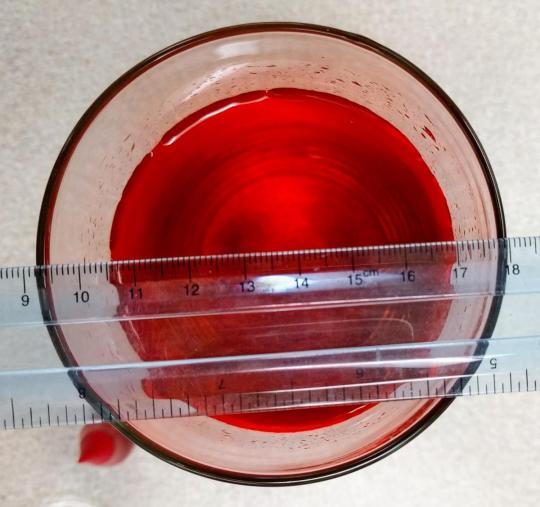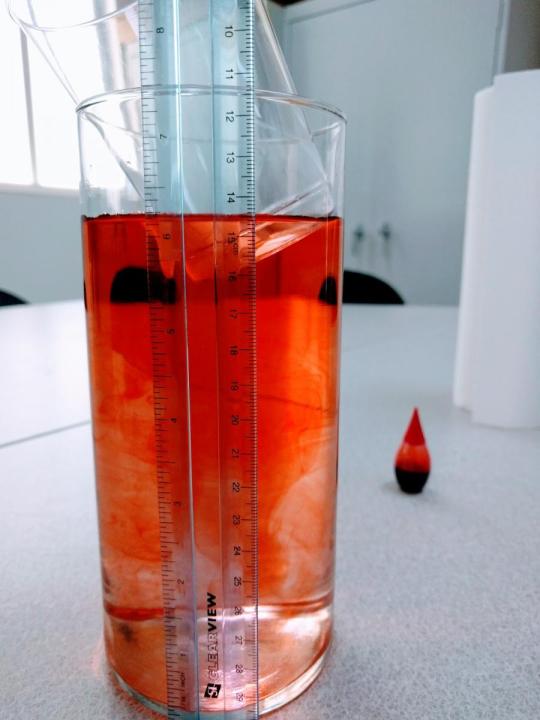Lesson 3: What a Mess! (optional)
[include purpose of warmup, if any]
This modeling lesson is designed following Dan Meyer’s Three Act Math plan. It ideally is postponed until a few weeks after the rest of the cycle, and revisits the context of displacement by a floating object in a new context, with an opening video of a potential overflow situation. A discussion will lead to the two questions: “Will it overflow?” And “How many pennies will it take to make it overflow?” Student teams (the same teams as for the boat building) then work on determining their best estimates for these questions (asking for information they think will help them determine). The mathematics that students will have to access involves estimating the volume of a cylinder, and combining that information with their understanding of displacement from the rest of the cycle.
This lesson helps to assess and cement understanding of the proportional relationship between the number of pennies floating and displacement, in the context of a different mathematical question.
Activities:
Setup
- Video ready to show: The video ends with a minute of a black screen; close or stop the video when you reach that point [Note: use version with measuring, and extending to 20 pennies added. On both videos, add ~1 min of black screen at end to avoid “related videos”]
- Class graph with boat challenge data displayed on the wall somewhere without comment
- Student teams (same as for boat challenge) will need paper and pencil
- Printouts of photos of water height, diameter of vase, and cup dimensions (all on separate pieces of paper) or way to show them individually to teams such as phone or iPad
Narrative
[include purposes and a discussion of what students should be doing/thinking/discussing/struggling with]
Students will watch brief video of someone preparing to put pennies in a cup floating in a vase. A discussion will lead to an exploration of the questions “will it overflow?” and “how many will it take to overflow?” Teams will investigate, asking for information from the teacher as they need it, then share their reasoning as selected and sequenced by the teacher. Finally, a video showing the full experiment is shown, revealing the answers to the questions.
Launch (narrative could include comments on timing)
Text
Show students video without prompting what they should watch for and without recalling the boat challenge: “I found this little video that got me wondering. What does it make you wonder about?”
The video ends after 20 pennies have been dropped into the cup. Questions to prompt and draw out students’ wondering could include
- what's going to happen when he puts in all those pennies?
- The cup will still float
- The cup will tip over
- The water level will go up
- The water will overflow
- That's a lot of pennies. Did anyone see how many he's got? [100] Do you think the cup can float all of them? What do you think might happen if he tries to put them all in?
- Overflow
- The cup will sink
- It will hold them all without overflowing
Settle on the questions “will it overflow?” and “how many will it take to make it overflow or sink (whichever comes first)?”
Task statement
Decide whether the cup can hold all the pennies without the vase overflowing or the cup sinking. Decide how many pennies it will take to overflow the vase or sink the cup. I might be able to find some more information about the situation; if there is a specific piece or two of information that would help you decide, ask and I will tell you if I can find it.
Orchestrating & Monitoring (narrative could include comments on timing)
Ask teams to work out their best estimates for the questions and to be prepared to describe how they arrived at their estimates. Give them 15 minutes to work on this.
Be prepared to give out the following info:
- Pictures of things specifically requested (they can write down info so you can show other teams, or you can make multiple copies)
- It is just water in the watering can in the video
- Number of pennies in video:100
- Formula for volume of a cylinder: V = (area of base)*(height). In this case, area of the base is the area of a circle: \pi r2
- Conversion from inches to cm: 1 in = 2.54 cm
- 1 cubic cm = 1 ml
- Your discretion, not needed for solution: mass of penny = 2.5 grams; mass of water = 1 gram/ml
If teams seem at sea, you could refer to the boat challenge graph on the wall [the boat challenge related “change in water level” directly to “number of pennies,” without the mass of pennies and water coming into play]
Watch for teams with good but different reasoning. See anticipated solutions below. If possible, choose one group that calculated the volume of the space at the top of the vase, and another that estimated the rate at which the water level was rising as pennies were added.
Also watch for teams that use similar techniques but arrive at significantly different answers because of different assumptions or different estimates from watching the video.
When groups have strategies and are nearing their estimates, give them a two-minute notice to be ready to explain their technique.
Discussion (could be synthesis; narrative could include comments on timing)
If you have teams that estimate that the cup will sink before the vase overflows, those estimates (how many pennies it will take to sink the cup) need to be in a separate category in the discussion than the how-many-to-overflow estimates.
Have at least two teams present their (preferably different) methods and estimates. Ask other teams to discuss among themselves the sources of difference between the answers--either different methods or different assumptions fed into similar methods; then gather ideas as a class.
After a discussion of sources of difference, give teams 5 minutes to refine their estimates if they want. Collect teams’ estimates on pieces of paper, and place on the white board in order from smallest to largest. Invite the class to eyeball a “middle of the pack” estimate for the overall class estimate. Some may want to calculate an average (mean); you can do that and also record the median estimate.
Finally, show the full video https://youtu.be/g0RFwATxpyM?rel=false
A final brief discussion of sources of errors in estimates may be in order
Anticipated solutions
- It will be clear to most students from the opening video that the water level in the vase will reach the top of the vase well before the cup sinks
- Some groups may calculate the volume of the empty space at the top of the vase. Reading from the pictures, the inside diameter of the vase is about 8.5 cm. The height from the top of the water to the top of the vase is about 3.3 cm. These give a volume of about 187 cm3. Translating this to number of pennies depends on your class data from the main challenge; if we use 2.5 ml/penny, we get about 75 pennies
- Some groups may try to estimate how much the water “goes up” with each group of five pennies added, in the first 20 pennies which are shown in the video. If they estimate that each 10 pennies takes up ⅙ of the empty space at the top of the vase, then they might estimate a total of 60 pennies will make the vase overflow
Anticipated misconceptions and challenges
Students may not remember what they learned and observed in the boat challenge. You may have to ask some questions to remind them to look at their work from those activities.
Images for classroom use


Student online materials (will be links for teacher to post)
Timeline:
Activity 1: (Warmup:): 20 minutes

